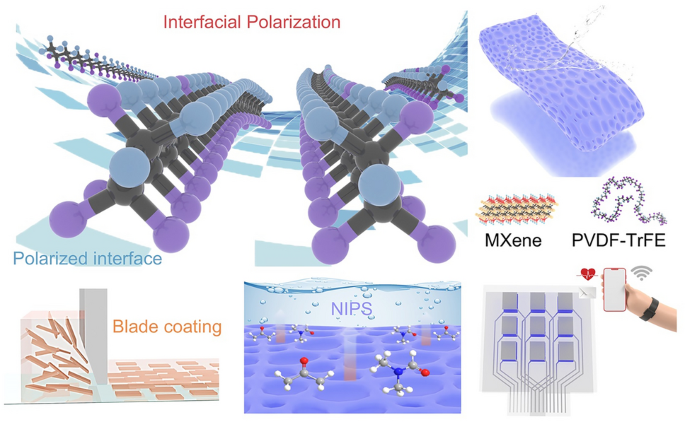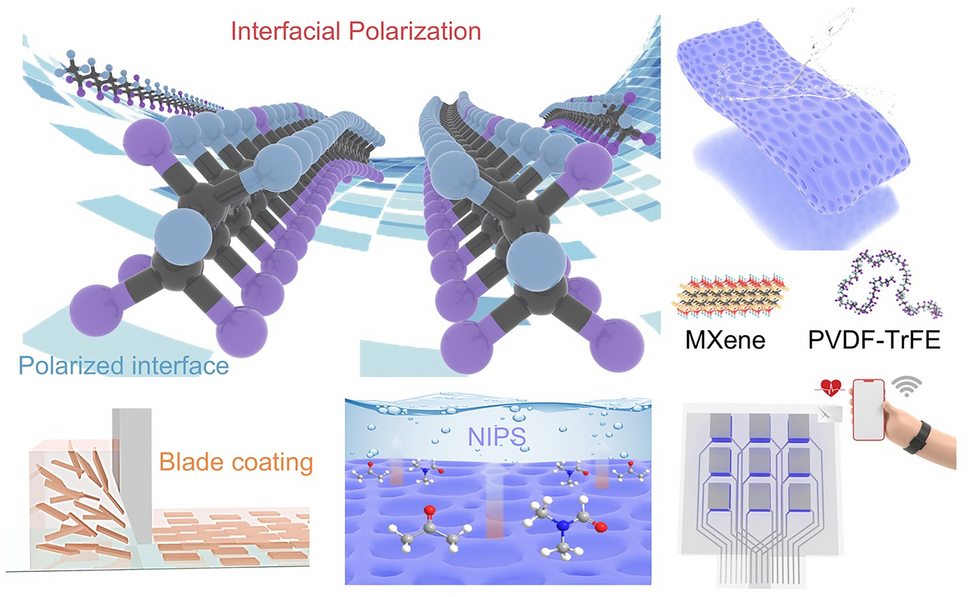Dual Structure Reinforces Interfacial Polarized MXene/PVDF‑TrFE Piezoelectric Nanocomposite for Pressure Monitoring
Published in Materials

Researchers from Southwest Jiaotong University and Shanghai Jiao Tong University have developed a high-performance piezoelectric nanocomposite by engineering a dual-structure interface between MXene and PVDF-TrFE. This innovative design combines oriented MXene distribution and a porous microstructure, significantly enhancing interfacial polarization and piezoelectric response. As a result, the material achieves an eightfold increase in low-pressure sensitivity and triples the electric output compared to conventional composites, while maintaining excellent flexibility and durability over 20,000 cycles.
Integrated into wearable sensors and powered by a 1D convolutional neural network (1D-CNN), the composite can accurately detect and classify subtle physiological signals such as artery pulse waves and finger flexion with up to 99% accuracy. A 3×3 sensor array was further developed for wireless pressure distribution monitoring, demonstrating strong potential in smart wearables, health monitoring, and human-machine interaction systems.
Why This Matters:
- Enhanced Piezoelectricity: Through interfacial polarization and structural design, the composite boosts spontaneous polarization from 0.56 to 31.41 Debye, tripling piezoelectric output and increasing low-pressure sensitivity by 8×.
- Smart Structural Design: The combination of oriented MXene distribution and porous architecture not only prevents conductive bridging but also improves flexibility, durability (over 20,000 cycles), and stress concentration management.
- AI-Powered Recognition: Integrated with a 1D-CNN deep learning model, the sensor can accurately distinguish finger flexion angles and different finger movements with up to 99% accuracy, enabling intuitive human-machine interaction.
Key Applications:
- Physiological Monitoring: The sensor successfully detects artery pulse waves, identifying key features like percussion, tidal, and dicrotic waves—critical for cardiovascular health tracking.
- Pressure Mapping: A 3×3 sensor array was developed for wireless pressure distribution monitoring, demonstrating potential in smart wearables, healthcare devices, and soft robotics.
Future Outlook:
This work presents a scalable, efficient strategy for designing next-gen piezoelectric materials. By combining materials engineering, structural optimization, and AI algorithms, it opens new pathways for flexible electronics, personalized healthcare, and intelligent sensing systems.
Stay tuned for more breakthroughs at the intersection of nanomaterials, AI, and wearable technology!
Follow the Topic
-
Nano-Micro Letters

Nano-Micro Letters is a peer-reviewed, international, interdisciplinary and open-access journal that focus on science, experiments, engineering, technologies and applications of nano- or microscale structure and system in physics, chemistry, biology, material science, and pharmacy.






Please sign in or register for FREE
If you are a registered user on Research Communities by Springer Nature, please sign in